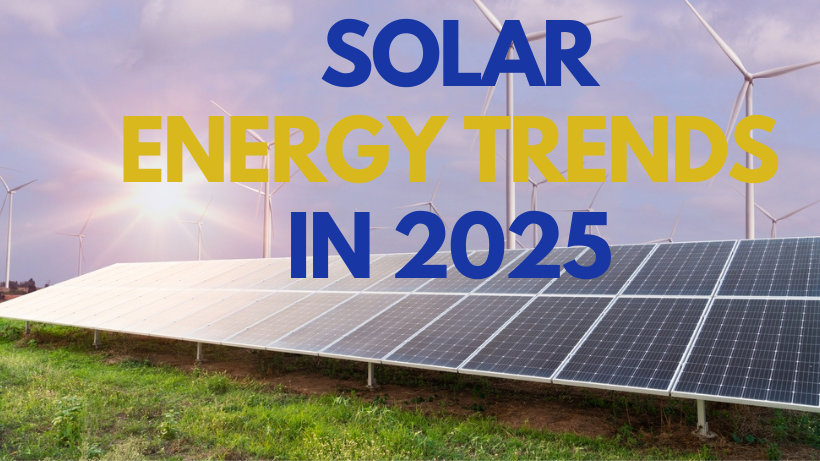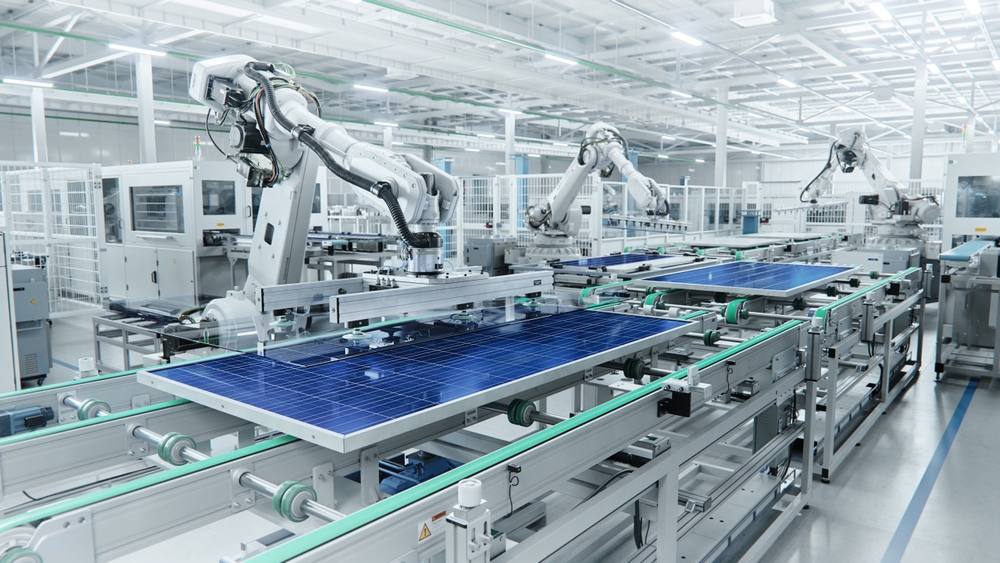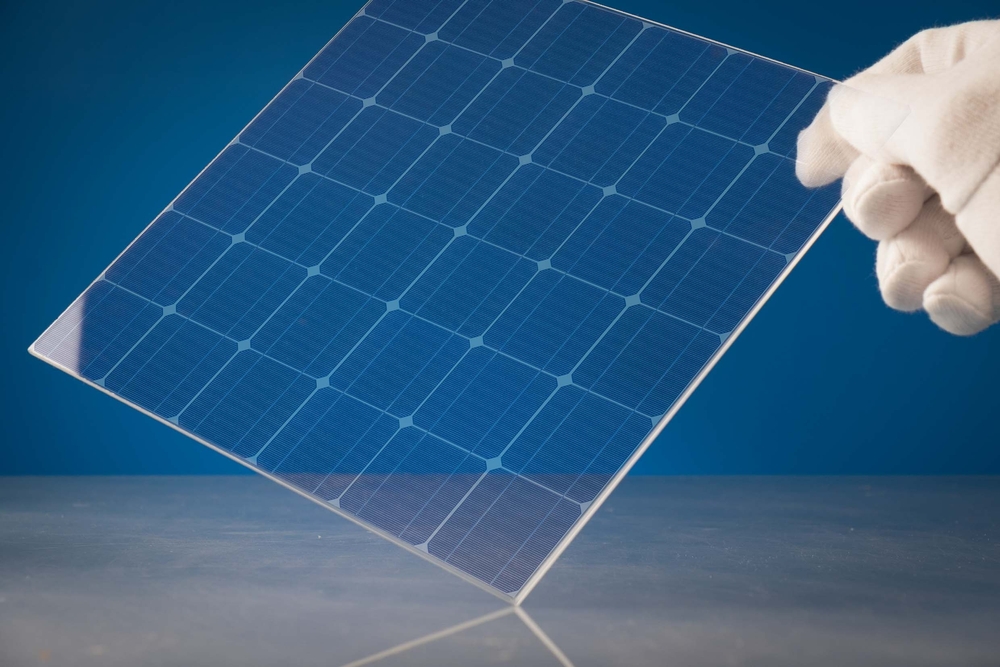
As the world transforms to renewable power, solar energy remains a game-changer. The solar industry is undergoing a revolutionary transformation as we approach 2025 with innovative concepts and strategies. This blog examines the most interesting developments in solar energy for 2025, enlightening trimming technologies, useful applications, and their worldwide effects.
1. Advanced Photovoltaic Technologies: Solar Industry’s Progress
The establishment of solar power generation has been photovoltaic (PV) technology, which is expected to see previously unrecognized advancements in 2025. Solar industry’s progress in solar cells, from more efficient to cheaper perovskite-based panels, ensure a remarkable increase in energy production. Higher adoption rates in the residential and commercial sectors are being made possible by these innovations.

Furthermore, solar energy is now more widely available and cost-effective than ever despite new technologies like multi-junction cells that are pushing efficiency limits above 50%. These developments are addressing problems like decreased effectiveness in poorly lit or shaded areas. The PV landscape in 2025 is more promising than ever due to significant research investments from the public and private sectors. This development increases consumer trust in solar power as a dependable and sustainable solution in addition to improving power generation.
2. Rise of Artificial Intelligence in Solar Energy Management
Through the optimization of energy production and consumption, artificial intelligence (AI) is transforming solar energy systems. AI systems improve solar panel maintenance by spotting inefficiencies or possible problems before they become serious. AI-powered predictive analytics can also forecast energy consumption, allowing for more intelligent grid management. For solar plants around the world, this integration assures optimal efficiency and lower operating costs.
Furthermore, microgrid systems driven by AI are growing in popularity because they enable decentralized energy distribution and enhanced resilience in the event of a power outage. By 2025, artificial intelligence (AI) will be an essential feature of modern Web of Things solar infrastructure, working in perfect harmony with devices to track and regulate energy consumption. By giving consumers access to real-time energy usage data, these systems empower them and promote a culture of more efficient and considerate energy use. Additionally, more effective solar panel layouts that ensure optimal sunlight exposure for maximum energy capture are being created using AI tools.
3. Solar Energy Storage Solutions: Bridging the Gap
Advanced energy storage methodologies will be developed by 2025. Solid-state batteries and lithium-sulfur alternatives are examples of recent advancements in battery technology. These storage systems are essential for stabilizing energy supplies, especially during times of high demand or overcast days. They also offer greater storage capacities and quicker charging cycles.
Additionally, new research on flow batteries and hydrogen storage offers exciting opportunities for long-term, large-scale energy storage, ensuring a steady supply of solar power even in areas with less sunshine. The development of modular battery systems enables customized storage solutions that satisfy the distinct needs of commercial, residential, and industrial users. As energy storage becomes more affordable and efficient, solar is becoming a more dependable choice for both individual users and national grids. This is because it fills the gap between the production of renewable energy and a reliable power source.
4. Leveraging Unrealized Potential with Floating Solar Farms
On bodies of water, floating solar farms are gaining popularity as a space-efficient alternative to land-based systems. Because water has a cooling effect, these farms not only save land but also lower water evaporation and increase panel efficiency. Leading the way are nations like China, India, and Japan, demonstrating the viability and expandability of these cutting-edge solar power initiatives.
Aside from their usefulness, floating solar farms and aquaculture can coexist and foster a mutually beneficial partnership that boosts regional economies and food production. Floating solar installations are growing more resilient and versatile to a variety of aquatic environments, including offshore waters and reservoirs, cheers to developments in anchoring technologies and materials. By utilizing otherwise unused water surfaces, these farms represent a crucial step in optimizing space and resources for renewable energy production.
As more governments and corporations realize floating solar’s dual advantages of producing energy and protecting the environment, its use is growing worldwide. Floating solar is a smart and sustainable solution because this trend is especially noticeable in areas with limited land availability.
5. Transparent Solar Panels: Redefining Urban Energy
Imagine skyscrapers and windows generating electricity. Transparent solar panels are making this vision a reality. These panels integrate seamlessly into urban environments, transforming everyday structures into energy-generating assets. With aesthetic appeal and functional efficiency, they represent a significant step toward achieving net-zero energy buildings.

Beyond windows, transparent solar panels are being incorporated into vehicle sunroofs and portable electronics, expanding their potential applications. These advancements enhance energy efficiency and make solar technology an integral part of modern design, blending functionality with visual appeal. Transparent solar panels transform how we think about and use energy in urban environments by transforming objects, vehicles, and buildings into power generators.
Future developments in dependable solar technology may result in panels that are almost invisible and extremely energy-efficient. This finding has the potential to drastically alter architectural style by facilitating whole cities to serve as massive solar power plants without sacrificing allure.
6. Electric Vehicles Powered by Solar Energy: Future Toward Sustainability
EVs are revolutionizing environmentally friendly transportation. EV charging stations that run on solar power are becoming more and more popular as they are a wise and environmentally friendly option. Furthermore, contemporary solar-powered vehicle designs reduce the need for traditional charging stations by enabling vehicles to generate electricity while they are moving.
In regions with abundant sunshine, where solar-powered EVs can drastically cut carbon emissions from the transportation sector, this shift is particularly apparent. In addition to having a greater range, EVs with solar panels mounted on their bodies are also more useful for long journeys. In anticipation of 2025, an essential part of a more sustainable energy future.
Additionally, the combination of solar energy and electric vehicles encourages the creation of more robust energy systems. Communities can establish localized energy ecosystems that are less reliant on centralized power grids by combining solar charging stations with battery storage.
7. Large-Scale Solar Plants: Powering Nations
The construction of large-scale solar plants is a pivotal trend in 2025. These projects, often spanning thousands of acres, are vital for meeting the growing global energy demand. With the rise of cutting-edge technology and unwavering government support, solar power plants are shining brighter than ever. They’re not just eco-friendly but also more efficient and wallet-friendly, making a hefty contribution to our national energy grids.
Take a look at the spectacular mega solar farms nestled in vast deserts or innovative hybrid projects that brilliantly blend solar energy with wind or hydropower. These initiatives are redefining the future of energy production!. These massive installations are energy powerhouses and symbols of global commitment to renewable energy. They also offer special chances to incorporate cutting-edge technologies, like drone-based maintenance and artificial intelligence (AI) for performance enhancement.
These plants’ size and effectiveness highlight their contribution to quickening the switch to renewable energy. Countries are making significant strides toward environmental sustainability and energy independence by utilizing solar energy so widely.
8. Rural Solar Electricity Projects: Strengthening Societies
Solar electricity projects are assisting in bridging the energy gap in rural and underserved areas. Remote areas can now access dependable and reasonably priced electricity owing to community-based installations and portable solar kits. By fostering the growth of small businesses, these programs not only raise living standards but also strengthen local economies.
Solar energy is also helping these areas’ healthcare and educational institutions, guaranteeing that essential services are available even in off-grid areas. Projects that empower women and marginalized groups through solar entrepreneurship are gaining momentum and further enhancing the revolutionary power of solar energy. Solar technology increased in rural areas as it became more affordable and accessible, providing long-term, sustainable answers to persistent energy problems.
9. Solar Power: Impact of Solar Energy on Climate
Achieving global climate goals needs solar energy because it can provide clean energy in replace of fossil fuels. In order to reduce environmental problems and transition to sustainable energy sources, governments and organizations around the world are investing in solar energy. The potential for reducing carbon emissions from solar energy is truly remarkable. The combination of solar energy with carbon capture technology may increase its effects and result in a more comprehensive strategy for environmental sustainability. Solar energy is not just the cure but it is also the key component to fight against climate change, offering both long-term and short-term climate advantages.
10. Solar Energy Trends: Impact on Global Economy:
One of the key drivers of economic growth is the solar energy sector. Millions of jobs created by it, from installation and production to research and maintenance. The development of industry’s progress is projected to generate even more opportunities, promoting sustainability and economic resilience.
Lower energy prices, greater energy independence, and better trade balances for countries that export solar are some of the knock-on effects. Furthermore, the growth of the solar industry fosters innovation and industrial diversification, solidifying its position as a pillar of contemporary economies.
Solar Power is a key to solving global energy security issues. It improves national energy security by lowering dependency on imported fuels and expanding energy resources.
11. Challenges and Strategies in the Solar Industry:
Besides its many benefits, the solar industry faces many obstacles like waste management, high initial cost and land use conflicts. However, to ensure sustainable growth, these problems are addressed by creative solutions like dual-use land systems (like agri voltaics), enhanced financial models and recycling initiatives. Collaboration in the expansion of renewable energy is facilitated by community engagement and open decision-making procedures which reduce opposition to large-scale solar projects.
By tackling these issues together, the public and private sectors can guarantee the industry’s sustainability and resilience.
12. Powering Future: Role of Solar Power in Reaching Energy Security
Solar energy is the one important way to approach the worldwide issue of energy solutions. Solar energy strengthens national energy security by lowering dependency on imported fuels and expanding energy sources.
Resilience against natural disasters and power outages is further enhanced by microgrid systems and distributed solar installations. Modern energy storage systems techniques cannot function without solar power because the incorporation adds an additional layer of security.
13. Government Policies and Incentives: Promoting the Adoption of Solar
To speed up the adoption of solar, supportive policies and perks are essential. Governments are enticing individuals and businesses to transition to solar energy By providing tax breaks, subsidies, and feed-in tariffs. Because of these incentives, the global solar energy market is growing at record rates.
Developing nations can now further adopt solar power thanks to international partnerships and funding programs, paving the way for a more sustainable and inclusive energy future. These initiatives guarantee that the use of solar energy surpasses both geographic and financial barriers.
FAQS:
- What is the future of Solar Panels?
Solar panels’ increasing adaptability, affordability, and efficiency are key factors for their future. The goal of the research is to create panels that produce electricity in low light and even at night by using stored solar energy. Solar panels will remain at the forefront of the renewable energy revolution due to constantly being improved and advanced.
- What is the new technology for solar panels in 2025?
Many groundbreaking solar panel technologies or methodologies are scheduled to be released in 2025, including:
- Bifacial panels: By absorbing sunlight from both directions, they double their efficiency.
- Quantum dot solar cells: Boosting the absorption of light and more efficiently turning it into energy.
- Perovskite solar cells: Providing a wide range of applications and high efficiency.
- Tandem solar cells: Merge several materials to produce efficiency levels that break records.
Conclusion: Embracing the Bright Future Powered By Solar Energy
The trends influencing solar energy in 2025 demonstrate how capable the sector is of revolutionizing the world’s energy supply. A sustainable future is being developed by solar energy, from cutting-edge photovoltaic technologies to floating solar farms and AI-driven inventions.
For future generations, we can guarantee a cleaner, greener planet by adopting these trends. Global cooperation, policy support, and innovation come together to make 2025 a critical year in the transition to a solar-powered world.